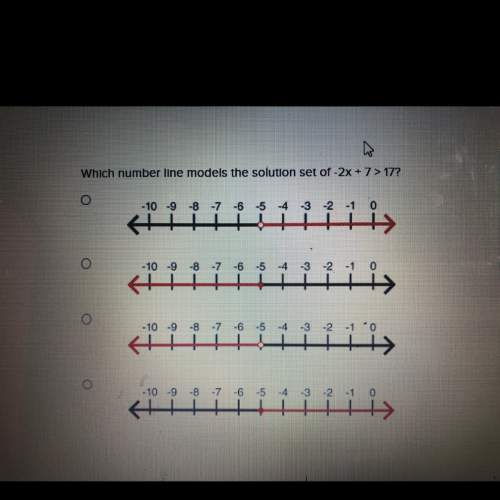Which statement about rhombuses and parallelograms is true?
a) rhombuses always have fo...

Mathematics, 29.10.2019 06:31 ecarter8967
Which statement about rhombuses and parallelograms is true?
a) rhombuses always have four equal sides; parallelograms sometimes do not.
b) rhombuses always have four right angles; parallelograms sometimes do not.
c) parallelograms always have opposite sides equal; rhombuses sometimes do not.
d) parallelograms always have opposite sides parallel; rhombuses sometimes do not.

Answers: 1
Another question on Mathematics

Mathematics, 21.06.2019 19:00
The graph shows the charges for a health club in a month. make a function table for the input-output values. writes an equation that can be used to find the total charge y for the number of x classes
Answers: 2

Mathematics, 21.06.2019 21:30
Aculture started with 4,000 bacteria. after 5 hours, it grew to 5,200 bacteria. predict how many bacteria will be present after 19 hours. round your answer to the nearest whole number.
Answers: 1

Mathematics, 21.06.2019 21:50
Scores on a university exam are normally distributed with a mean of 78 and a standard deviation of 8. the professor teaching the class declares that a score of 70 or higher is required for a grade of at least “c.” using the 68-95-99.7 rule, what percentage of students failed to earn a grade of at least “c”?
Answers: 1

Mathematics, 21.06.2019 23:00
Each of the following data sets has a mean of x = 10. (i) 8 9 10 11 12 (ii) 7 9 10 11 13 (iii) 7 8 10 12 13 (a) without doing any computations, order the data sets according to increasing value of standard deviations. (i), (iii), (ii) (ii), (i), (iii) (iii), (i), (ii) (iii), (ii), (i) (i), (ii), (iii) (ii), (iii), (i) (b) why do you expect the difference in standard deviations between data sets (i) and (ii) to be greater than the difference in standard deviations between data sets (ii) and (iii)? hint: consider how much the data in the respective sets differ from the mean. the data change between data sets (i) and (ii) increased the squared difference îł(x - x)2 by more than data sets (ii) and (iii). the data change between data sets (ii) and (iii) increased the squared difference îł(x - x)2 by more than data sets (i) and (ii). the data change between data sets (i) and (ii) decreased the squared difference îł(x - x)2 by more than data sets (ii) and (iii). none of the above
Answers: 2
You know the right answer?
Questions



Social Studies, 04.03.2021 20:00

Mathematics, 04.03.2021 20:00


Mathematics, 04.03.2021 20:00

Computers and Technology, 04.03.2021 20:00

Spanish, 04.03.2021 20:00

Mathematics, 04.03.2021 20:00


Biology, 04.03.2021 20:00

Biology, 04.03.2021 20:00



Mathematics, 04.03.2021 20:00



Mathematics, 04.03.2021 20:00





